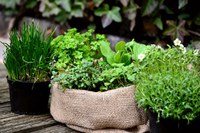Dakota Gardener: Herb your enthusiasm
(Click an image below to view a high-resolution image that can be downloaded)
By Emily How, Horticulture agent
NDSU Extension – Ward County
Adding aroma, texture and some fun, herbs are a fantastic addition to any garden. When choosing my garden herbs, I often go through the old song, “Parsley, Sage, Rosemary, and Thyme” and then add my kitchen staples of basil, cilantro and mint.
This year I decided to get a little experimental and bought some cinnamon basil seeds. I will admit, they were on sale and I was curious, but it has been an exciting addition to the garden. Watching the basil grow and waiting to smell the aroma was a good way to pass the time in my garden. It also got me looking at different herbs that can be grown in the garden, beyond the kitchen staples.
Herbs have been used in gardens dating back to medieval times (and further) and were traditionally used for medicine, spiritual rituals and cooking. Herbs differ from spices in that herbs come from the green, leafy part of the plant whereas spices come from the stem, root, seed, flower or bark. For example, cilantro is an herb but coriander is a spice. Both come from the same plant Coriandrum saticum, but cilantro is the leaves of the plant whereas coriander is the seed.
Many herbs are easy to grow in North Dakota gardens and are usually bought as plants. If you want to experiment with growing uncommon herbs, it is best to use seeds as more uncommon varieties can be found. Not all herb seeds need to be started indoors, some, such as basil, can be directly seeded into the soil. Others, such as stevia, should be started indoors 6 to 8 weeks before the last frost.
Many of these herbs can be used in cooking, everything from sweetening a dish to adding citrusy flavors to dishes. To use these herbs year-round, many can be planted in pots and brought indoors for the winter, or you can preserve the herbs for future uses. The NDSU Extension publication Harvesting Herbs for Healthy Eating, available at ndsu.ag/herbs, has information on some of the more commonly-used herbs.
Here is a list of some fun herbs to experiment with in your garden next year:
- Borage – used dried or fresh as an herbal seasoning, in tea or other drinks, or as a garnish
- Chamomile – commonly used to make herbal infusions for beverages
- Chervil – related to parsley with a mild flavor of licorice or anise
- Mint – experiment with different flavors such as peppermint, spearmint, chocolate mint or pineapple mint
- Basil – experiment with different flavors such as lemon basil, Thai basil or cinnamon basil, often used in teas or baked goods
- Stevia – leaves are used as a sugar substitute
- Fennel – highly flavorful, similar-tasting to anise; all parts are edible
- Sorrel – bright and tart flavor, compliments items with fatty creaminess, such as yogurt and sour cream
- Lemon balm – best used fresh on fish, poultry, vegetables and as a tea or beverage infusion
For more information about gardening, contact your local NDSU Extension agent. Find the Extension office for your county at ndsu.ag/countyoffice.
NDSU Agriculture Communication – July 26, 2024
Source: Emily How, 701-857-6444, emily.how@ndsu.edu
Editor: Kelli Anderson, 701-231-7006, kelli.c.anderson@ndsu.edu




